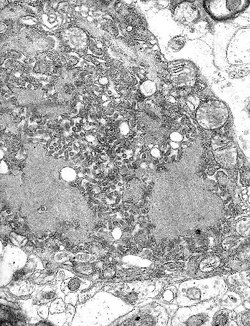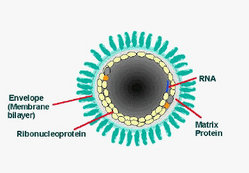A 15-year-old girl has become the sixth person in medical history to live through an advanced case of rabies and the first one to do so without receiving the rabies vaccine. She received a novel therapy, and scientists are now considering whether it was the key to her recovery. When Jeanna Giese of Fond du Lac, Wis., was admitted to Children's Hospital of Wisconsin in Milwaukee last October, she was lethargic and had experienced several days of double vision, fatigue, nausea, and some numbness. Her prospects were bleak because a month earlier, a bat had bitten her, says pediatrician Rodney E. Willoughby, who has treated Giese ever since she arrived at the hospital.
Like most physicians, Willoughby had never seen anyone with rabies that had progressed to symptoms. The rabies vaccine cures most people bitten by a rabid animal in developed countries, but if a rabies exposure goes untreated, the patient almost always dies within days of the appearance of symptoms.
Somehow, Giese pulled through. She's still weak and barely able to walk but is back home undergoing physical therapy. While Giese was in the hospital, Willoughby and other physicians designed a bold new treatment for her. But even they can't say whether their approach cured her, or whether some resilience on the girl's part or some characteristic of the rabies virus that infected her permitted her to recover.
"There are years of work, potentiality, in trying to answer some of these questions," says Charles Rupprecht, chief of the Rabies Section at the Centers for Disease Control and Prevention (CDC) in Atlanta, who collaborated with Willoughby and others on the case. Their success could rekindle experimentation on animals for developing new rabies treatments. Meanwhile, Rupprecht says, the response from the scientific community has been a mix of admiration, disbelief, and a "wait-and-see attitude." After all, he notes, "this is a sample size of one--over 4,000 years."
SLOWING THE BRAIN Giese's harrowing journey began in a church. She scooped up a fallen bat and then released it outside. As she did, the bat bit her finger. Thinking it was a scratch, she simply washed out the tiny wound with hydrogen peroxide.
A month later, her symptoms appeared. The bat bite made Willoughby guess rabies. He sent samples of Giese's blood, spinal fluid, saliva, and skin to CDC, where tests confirmed his suspicion.
With consent from Giese's parents and federal regulatory officials, Willoughby and a team of other doctors settled on a radical strategy that included experimental drugs and an induced coma. They didn't administer the rabies vaccine or antibodies to rabies virus because Giese had already started making antibodies to it. Furthermore, other patients hadn't benefited from such late vaccinations.
Rabies patients can die in many ways that show no pattern, says Willoughby, who is affiliated with the Medical College of Wisconsin in Milwaukee. These include sudden heart stoppages, strokes, and respiratory failures. Willoughby and his colleagues suspected that the brains of rabies patients send out signals that sabotage vital organs.
So, the team elected to slow the girl's brain activity using an anesthetic and drugs that inhibit the effect of glutamate, a chemical carrier of brain signals that causes problems when it's overabundant, as in patients with head injuries and a variety of brain disorders. The doctors also administered antiviral medication and put Giese on a breathing machine.
Some of this strategy is outlined in the Dec. 24, 2004 Morbidity and Mortality Weekly Report. The team plans to release more details later this year.
Willoughby says that a major element of this strategy was to buy time for Giese's immune system to eradicate the virus. In theory, shutting down her brain wouldn't hinder her immune response.
Her time in a coma was surprisingly uneventful. "She was supposed to try to die in lots of ways," Willoughby says. "We actually had a list taped to her chart. We had a game plan for every possibility."
Instead, Giese made abundant antibodies against rabies virus, and after just a week in a coma, she no longer showed any sign of infection. It was time to wake her up.
The first day out of the coma, Giese had normal vital signs but appeared lifeless. The next day, her knee reflexes came back. "Every day, it was like she was bringing us a new present; it was like Hanukkah," Willoughby says. Giese became fully conscious before she could speak, so she started using sign language, a skill she had learned in Girl Scouts, Willoughby says.
Giese spent more than 10 weeks in the hospital and was discharged Jan. 1. She's still steadily regaining her strength and mental faculties, Willoughby says.
Giese's recovery is unique, says neurologist Alan C. Jackson of Queen's University in Kingston, Ont. All five previous survivors of symptomatic rabies had received incomplete vaccination courses before their symptoms set in. And even then, only one of those people recovered without brain damage.
Jackson doubts that the coma was the key to success. "It's more likely that one of the drugs inducing the coma may have had antiviral actions," he surmises.
James J. Kazmierczak, Wisconsin's state public health veterinarian, is reserving judgment. He says that Giese's recovery might be fortuitous and that the novel treatment won't gain credence until it's replicated in another rabies patient. Meanwhile, he says, "we don't want people to think that rabies is now some sort of curable disease."
COPYRIGHT 2005 Science Service, Inc.
COPYRIGHT 2005 Gale Group




